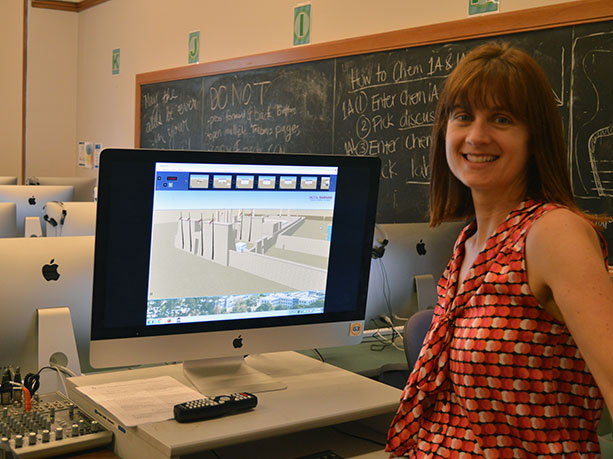On October 23, Dr. Elaine Sullivan, Assistant Professor in the History Department at UC Santa Cruz, visited the Digital Humanities at Berkeley program and the Department of Near Eastern Studies. Her visit was one of several workshops in DH at Berkeley’s series on 3D modeling. In addition to teaching a workshop on VSim, a platform for presenting and annotating 3D models for education and research, Sullivan shared her past and ongoing projects, as well as some thoughts on collaboration in the digital humanities.
 Sullivan’s career as a digital humanist began with her postdoctoral work at UCLA. As a project coordinator for Professors Diane Favro and Willeke Wendrich, Sullivan built 3D models of the Egyptian Temple at Karnak. Sullivan explained that though the temple site is still extant, it was important to capture the various changes to Karnak over its history. “One map or one model simply doesn’t express what’s going on,” Sullivan noted. Sullivan and the Digital Karnak team built a thirty phase 3D model, tracing architectural changes to the site over a period of 2000 years.
Sullivan’s career as a digital humanist began with her postdoctoral work at UCLA. As a project coordinator for Professors Diane Favro and Willeke Wendrich, Sullivan built 3D models of the Egyptian Temple at Karnak. Sullivan explained that though the temple site is still extant, it was important to capture the various changes to Karnak over its history. “One map or one model simply doesn’t express what’s going on,” Sullivan noted. Sullivan and the Digital Karnak team built a thirty phase 3D model, tracing architectural changes to the site over a period of 2000 years.
Sullivan was frustrated with the limited capacities for sharing a large, high fidelity model. When the Digital Karnak site launched in 2008, the team recorded videos flying through the model and provided a lower resolution model as a Google Earth layer. Sullivan recalled, “I could demonstrate the real, high-res model when I used a big gaming laptop [with a good graphics card and processor], but to share it I had to send people static videos. Losing that interactivity reduces the utility of a 3D model.”
Shortly thereafter, Lisa Snyder, an architectural historian and staff technologist at UCLA’s Institute for Digital Research and Education, proposed a platform focused on using 3D for research and teaching. The NEH-supported VSim project allows users to upload 3D content, annotate it, and record paths walking or flying through the mode from a variety of heights and angles. VSim and Digital Karnak have been invaluable to Sullivan’s teaching. “In most classes, almost none of my students have been to Egypt. They don’t have a sense of the monumentality of these sites. In VSim, we’ll walk through the temple at human eye level. They get it! Students get something closer to an embodied, visceral experience of the temple.”
Sullivan’s new project, 3D Saqqara, will expand upon her work with Digital Karnak by adding a geospatial information systems (GIS) component to enrich models of the site. Saqqara, home to hundreds of monuments, served as a ritual and burial site for more than 3000 years. Sullivan is currently engaged in reconstructing the terrain at Saqqara. Working with undergraduate students, she has been digitizing 2D line data, creating elevation models, and utilizing lidar data (3D information on the surface of manmade and natural environments collected with use of pulsed lasers and aircraft). “We’re able to historicize this data. We can look at the historic ground level from earlier excavations and posit that things would have been 5 meters lower than they are currently,” Sullivan noted. Capturing the relationship between the built and natural landscape, such as lines-of-sight between important cult places, helps researchers and students better understand ancient peoples’ perception of the ritual landscape.
Sullivan stressed the importance of a collaborative mindset and locating a community of peers when working on projects of this scale. Sullivan explained that she often benefited from working with in physical proximity to peers at UCLA’s Center for Digital Humanities. Sullivan recalled that by talking and troubleshooting with her peers, she was able to learn about many tools that were not directly applicable to her research at the time, but informed her ideas for future research. When Sullivan was first exposed to GIS at the CDH, it was not a primary tool in the Digital Karnak project, but it is now an essential tool for her analysis in 3D Saqqara. “I didn’t have a background in computer science, but I was able to learn these technologies and see their impact on a variety of humanistic research through my peers,” Sullivan explained.
Sullivan also pointed to her undergraduate research assistants as invaluable members of her project teams. Over the years, Sullivan has worked with undergraduates majoring in classics, history, and anthropology. “They didn’t have technical backgrounds, but they had taken my egyptology classes. They loved the subject matter; they found going through publications interesting. I taught them what they needed to know about 3D modeling and GIS, and they were able to engage critically with the data they were creating. They understood, in an intuitive way, the importance of these research questions.”
VSim and the Digital Karnak model are available on workstations at the 212 Wheeler computer lab for the rest of the semester. For access credentials, please contact e-mail digitalhumanities@berkeley.edu.
Additional resources: